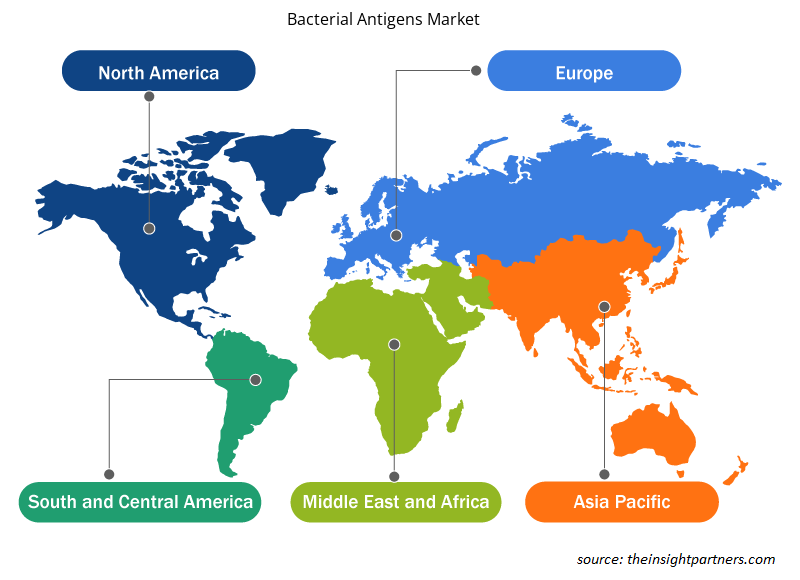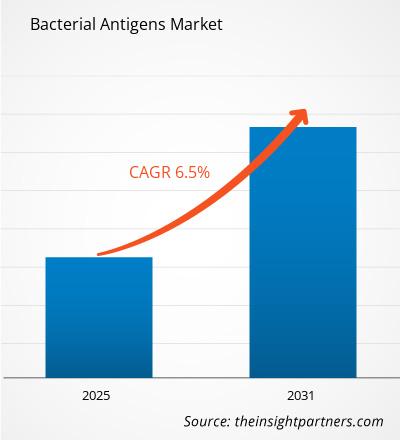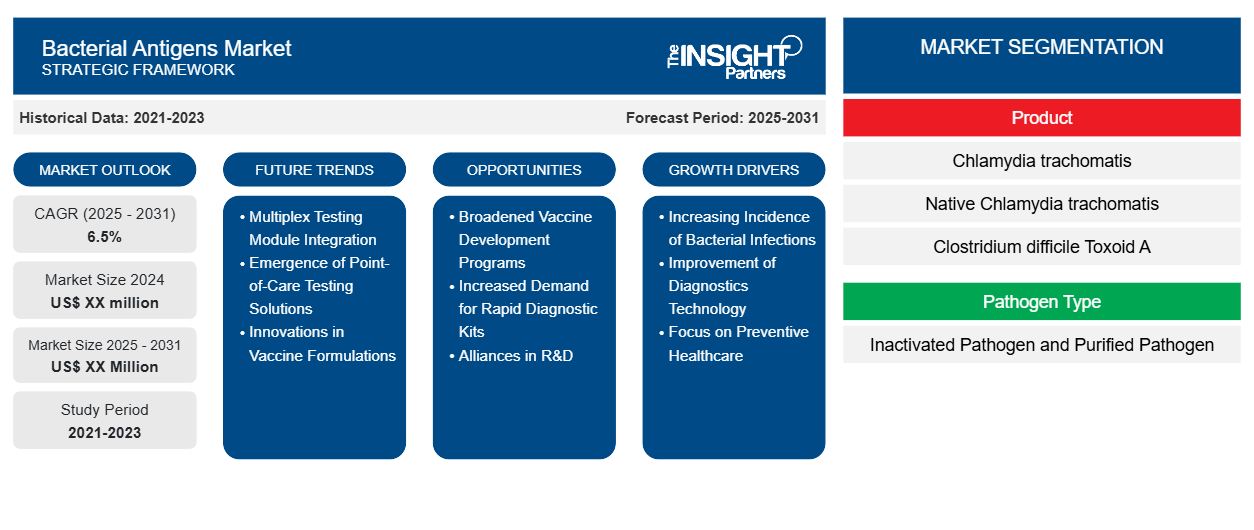Der Markt für bakterielle Antigene wird voraussichtlich von 2023 bis 2031 eine durchschnittliche jährliche Wachstumsrate (CAGR) von 6,5 % verzeichnen, wobei die Marktgröße von XX Millionen US-Dollar im Jahr 2023 auf XX Millionen US-Dollar im Jahr 2031 wachsen wird.
Der Bericht ist segmentiert nach Produkt (Chlamydia trachomatis, natives Chlamydia trachomatis, Clostridium difficile Toxoid A, Clostridium difficile Toxoid B, native Lipoteichonsäure, Neisseria gonorrhoeae, rekombinantes Protein G und Trichomonas vaginalis), Erregertyp (inaktivierter Erreger und gereinigter Erreger), Anwendung (ELISA, Immunoassay, SDS-PAGE, Hämagglutination und Agglutinationstest), Endbenutzer (Krankenhäuser und Kliniken, Diagnoselabore und -zentren, akademische und Forschungsinstitute).
Zweck des Berichts
Der Bericht „Markt für bakterielle Antigene“ von The Insight Partners soll die aktuelle Situation und das zukünftige Wachstum sowie die wichtigsten treibenden Faktoren, Herausforderungen und Chancen beschreiben. Dies wird verschiedenen Geschäftspartnern Einblicke geben, wie zum Beispiel:
- Technologieanbieter/-hersteller: Um die sich entwickelnde Marktdynamik zu verstehen und die potenziellen Wachstumschancen zu kennen, damit sie fundierte strategische Entscheidungen treffen können.
- Investoren: Durchführung einer umfassenden Trendanalyse hinsichtlich der Marktwachstumsrate, der finanziellen Marktprognosen und der Chancen entlang der Wertschöpfungskette.
- Regulierungsbehörden: Zur Regulierung von Richtlinien und Überwachungsaktivitäten auf dem Markt mit dem Ziel, Missbrauch zu minimieren, das Vertrauen der Anleger zu bewahren und die Integrität und Stabilität des Marktes aufrechtzuerhalten.
Bakterielle Antigene Marktsegmentierung
Produkt
- Chlamydia trachomatis
- Einheimische Chlamydia trachomatis
- Clostridium difficile Toxoid A
- Clostridium difficile Toxoid B
- Native Lipoteichonsäure
- Neisseria gonorrhoeae
- Rekombinantes Protein G
- Trichomonas vaginalis
Erregertyp
- Inaktivierter Pathogen und gereinigter Pathogen
Anwendung
- ELISA
- Immunassay
- SDS-SEITE
- Hämagglutination
- Agglutinationstest
Endbenutzer
- Krankenhäuser & Kliniken
- Diagnostische Labore und Zentren
- Akademische und Forschungsinstitute
Endbenutzer
- Krankenhäuser & Kliniken
- Diagnostische Labore und Zentren
- Akademische und Forschungsinstitute
Passen Sie diesen Bericht Ihren Anforderungen an
Sie erhalten kostenlose Anpassungen an jedem Bericht, einschließlich Teilen dieses Berichts oder einer Analyse auf Länderebene, eines Excel-Datenpakets sowie tolle Angebote und Rabatte für Start-ups und Universitäten.
- Holen Sie sich die wichtigsten Markttrends aus diesem Bericht.Dieses KOSTENLOSE Beispiel umfasst eine Datenanalyse von Markttrends bis hin zu Schätzungen und Prognosen.
Wachstumstreiber auf dem Markt für bakterielle Antigene
- Zunehmende Häufigkeit bakterieller Infektionen: Die zunehmende Häufigkeit bakterieller Infektionen ist die treibende Kraft auf dem Markt für bakterielle Antigene. Neue Bakterienstämme und wachsende Antibiotikaresistenzen haben einen dringenden Bedarf an wirksamen Diagnose- und Präventionsinstrumenten geschaffen. Antigene spielen eine wichtige Rolle bei der schnellen und genauen Identifizierung der betreffenden Krankheitserreger und befeuern die Nachfrage nach innovativen Diagnosetests und Impfstoffen, die diese Antigene für ein verbessertes öffentliches Gesundheitsmanagement nutzen.
- Verbesserung der Diagnosetechnologie: Diese Fortschritte in der Diagnosetechnologie treiben das Wachstum des Marktes für bakterielle Antigene voran. Zu diesen neuen Technologien gehören PCR und Immunassays, die eine schnellere und präzisere Identifizierung bakterieller Krankheitserreger ermöglichen. Dies führt wiederum zu einer erhöhten Nachfrage nach bakteriellen Antigenen, die in solchen Tests verwendet werden, sodass Gesundheitsdienstleister Infektionen frühzeitig erkennen und so die Ausbreitung von Krankheiten verhindern und Behandlungspläne mit guten Ergebnissen für die Patienten individualisieren können.
- Fokus auf präventive Gesundheitsfürsorge: Die zunehmende Bedeutung präventiver Gesundheitsfürsorge treibt den Markt für bakterielle Antigene an. Diese Entwicklung umfasst innovative Forschung und Impfstoffe gegen die Krankheit durch bakterielle Antigene als vorbeugende Schutzmaßnahme gegen die meisten Krankheitsinfektionen. Ergänzt werden diese Entwicklungen durch staatliche Gesundheitsbehörden, die große Impfkampagnen durchführen, deren Ziel darin besteht, die Fallzahlen verschiedener übertragbarer Krankheiten zu senken.
Markttrends für bakterielle Antigene
- Integration von Multiplex-Testmodulen:
Die Integration von Multiplex-Testsystemen, die mehrere bakterielle Krankheitserreger gleichzeitig erkennen können, hat sich als wichtiger Trend auf dem Markt für bakterielle Antigene herauskristallisiert. Dies erhöht die Effizienz und Genauigkeit und verkürzt die Zeit bis zur Diagnose und Behandlung. Eine solche Ergänzung ist im klinischen Umfeld aufgrund der zunehmenden Komplexität und Koinfektionen erforderlich, was die Nachfrage nach einer Vielzahl bakterieller Antigene, die umfassende Tests ermöglichen, weiter steigert. - Aufkommen von Point-of-Care-Testlösungen:
POC-Tests revolutionieren den Markt für bakterielle Antigene, indem sie Diagnosen schneller und allgemeiner verfügbar machen. Diese tragbaren, einfachen und leicht zu bedienenden Geräte ermöglichen es dem Gesundheitspersonal, Tests in schwer erreichbaren, unterversorgten Gebieten schnell durchzuführen, wodurch Verzögerungen bei Diagnose und Behandlung minimiert werden. Daher besteht eine zunehmende Nachfrage nach bakteriellen Antigenen, die solche POC-Tests bestehen könnten, um frühe Ergebnisse zu erzielen und so bessere Patientenergebnisse und eine reibungslosere Gesundheitsversorgung zu unterstützen. - Innovationen bei Impfstoffformulierungen:
Ein wichtiger Trend auf dem Markt für bakterielle Antigene ist die Entwicklung formulierter Impfstoffe für bestimmte Indikationen. Mittlerweile wurden hochentwickelte, künstlich hergestellte Impfstoffe entwickelt, die durch bakterielle Antigenstimulation eine starke und dauerhafte Immunität hervorrufen. Solche Trends ergänzen die Impfstoffanwendungsprogramme in verschiedenen Teilen der Welt und gehen gleichzeitig das Problem der Antibiotikaresistenz an, indem sie den Bedarf an Antibiotika verringern. Die verbesserte Entwicklung von Impfstoffen treibt auch die Marktnachfrage nach bakteriellen Antigenen an.
Marktchancen für bakterielle Antigene
- Erweiterte Impfstoffentwicklungsprogramme:
Durch die Ausweitung der Impfstoffentwicklungsprogramme ergeben sich für die Märkte für bakterielle Antigene deutlich größere Wachstumschancen. Viele Regierungen und Pharmaunternehmen investieren viel in die Entwicklung und Herstellung neuartiger Impfstoffe gegen antibiotikaresistente Bakterien und andere neue Krankheitserreger. Der verstärkte Fokus auf Impfstoffinnovationen schafft einen starken Bedarf an bakteriellen Antigenen als wesentlichen Bestandteilen und schafft so einen starken Markt für die Entwicklung antigenbasierter Impfstoffe.markeplace for antigen-based vaccine development. - Erhöhte Nachfrage nach Schnelldiagnosekits:
Die steigende Nachfrage nach Schnelldiagnosekits im medizinischen Bereich ist eine der großen Aussichten für den Markt für bakterielle Antigene. Tatsächlich streben Gesundheitssysteme auf der ganzen Welt ständig nach schnelleren Diagnosen, um die weitere Übertragung von Infektionskrankheiten in der Bevölkerung zu verhindern. Folglich besteht eine größere Nachfrage nach bakteriellen Antigenen, die in Point-of-Care- und Schnelldiagnosetests eingesetzt werden. Daher ist dieses Szenario für den wachsenden Markt von Vorteil, insbesondere in den Regionen, die wirksame Diagnoselösungen für bakterielle Infektionen wünschen. - Allianzen in Forschung und Entwicklung:
Gemeinsame Partnerschaften von Wissenschaft und Industrie mit Regierungsbehörden sind Chancen für den Markt für bakterielle Antigene. Bis zur Einführung gemeinsamer Forschungsstudien zu bakteriellen Antigenen, die zu Diagnose- und Therapieprodukten führen, sind neue Entdeckungen vorprogrammiert. Dieser Rahmen kann genutzt werden, um die Entwicklung fortschrittlicher antigenbasierter Produkte zur effektiven Behandlung und Vorbeugung bakterieller Infektionen zu beschleunigen und so das Marktpotenzial weiter zu steigern.
Regionale Einblicke in den Markt für bakterielle Antigene
Die regionalen Trends und Faktoren, die den Markt für bakterielle Antigene während des Prognosezeitraums beeinflussen, wurden von den Analysten von Insight Partners ausführlich erläutert. In diesem Abschnitt werden auch die Marktsegmente und die Geografie für bakterielle Antigene in Nordamerika, Europa, im asiatisch-pazifischen Raum, im Nahen Osten und Afrika sowie in Süd- und Mittelamerika erörtert.

- Erhalten Sie regionale Daten zum Markt für bakterielle Antigene
Umfang des Marktberichts zu bakteriellen Antigenen
| Berichtsattribut | Details |
|---|---|
| Marktgröße im Jahr 2023 | XX Millionen US-Dollar |
| Marktgröße bis 2031 | XX Millionen US-Dollar |
| Globale CAGR (2023 - 2031) | 6,5 % |
| Historische Daten | 2021-2022 |
| Prognosezeitraum | 2024–2031 |
| Abgedeckte Segmente | Nach Produkt
|
| Abgedeckte Regionen und Länder | Nordamerika
|
| Marktführer und wichtige Unternehmensprofile |
|
Marktteilnehmerdichte für bakterielle Antigene: Auswirkungen auf die Geschäftsdynamik verstehen
Der Markt für bakterielle Antigene wächst rasant, angetrieben durch die steigende Nachfrage der Endnutzer aufgrund von Faktoren wie sich entwickelnden Verbraucherpräferenzen, technologischen Fortschritten und einem größeren Bewusstsein für die Vorteile des Produkts. Mit steigender Nachfrage erweitern Unternehmen ihr Angebot, entwickeln Innovationen, um die Bedürfnisse der Verbraucher zu erfüllen, und nutzen neue Trends, was das Marktwachstum weiter ankurbelt.
Die Marktteilnehmerdichte bezieht sich auf die Verteilung von Firmen oder Unternehmen, die in einem bestimmten Markt oder einer bestimmten Branche tätig sind. Sie gibt an, wie viele Wettbewerber (Marktteilnehmer) in einem bestimmten Marktraum im Verhältnis zu seiner Größe oder seinem gesamten Marktwert präsent sind.
Die wichtigsten auf dem Markt für bakterielle Antigene tätigen Unternehmen sind:
- Bio-Rad Laboratories, Inc.
- Enzo Life Sciences, Inc.
- Kreative Diagnostik
- Die Native Antigen Company Ltd.
- QED Bioscience Inc.
Haftungsausschluss : Die oben aufgeführten Unternehmen sind nicht in einer bestimmten Reihenfolge aufgeführt.

- Erhalten Sie einen Überblick über die wichtigsten Akteure auf dem Markt für bakterielle Antigene
Wichtige Verkaufsargumente
- Umfassende Abdeckung: Der Bericht deckt die Analyse von Produkten, Dienstleistungen, Typen und Endbenutzern des Marktes für bakterielle Antigene umfassend ab und bietet einen ganzheitlichen Überblick.
- Expertenanalyse: Der Bericht basiert auf dem umfassenden Verständnis von Branchenexperten und Analysten.
- Aktuelle Informationen: Der Bericht stellt durch die Abdeckung aktueller Informationen und Datentrends Geschäftsrelevanz sicher.
- Anpassungsoptionen: Dieser Bericht kann angepasst werden, um spezifische Kundenanforderungen zu erfüllen und die Geschäftsstrategien optimal anzupassen.
Der Forschungsbericht zum Markt für bakterielle Antigene kann daher dabei helfen, die Branchensituation und Wachstumsaussichten zu entschlüsseln und zu verstehen. Obwohl es einige berechtigte Bedenken geben kann, überwiegen die allgemeinen Vorteile dieses Berichts tendenziell die Nachteile.
- Historische Analyse (2 Jahre), Basisjahr, Prognose (7 Jahre) mit CAGR
- PEST- und SWOT-Analyse
- Marktgröße Wert/Volumen – Global, Regional, Land
- Branchen- und Wettbewerbslandschaft
- Excel-Datensatz
Aktuelle Berichte
Erfahrungsberichte
Grund zum Kauf
- Fundierte Entscheidungsfindung
- Marktdynamik verstehen
- Wettbewerbsanalyse
- Kundeneinblicke
- Marktprognosen
- Risikominimierung
- Strategische Planung
- Investitionsbegründung
- Identifizierung neuer Märkte
- Verbesserung von Marketingstrategien
- Steigerung der Betriebseffizienz
- Anpassung an regulatorische Trends





















 Kostenlose Probe anfordern für - Markt für bakterielle Antigene
Kostenlose Probe anfordern für - Markt für bakterielle Antigene